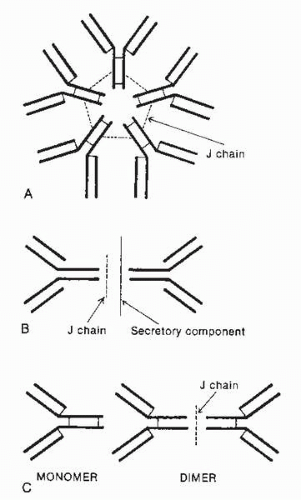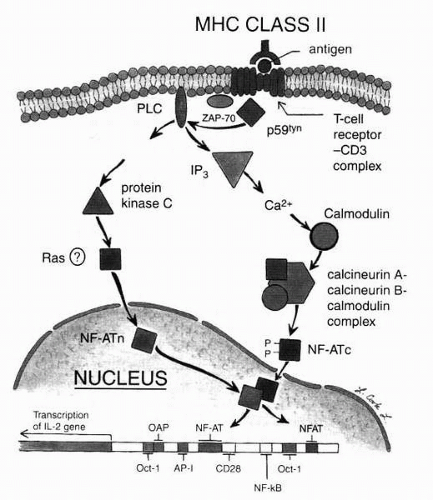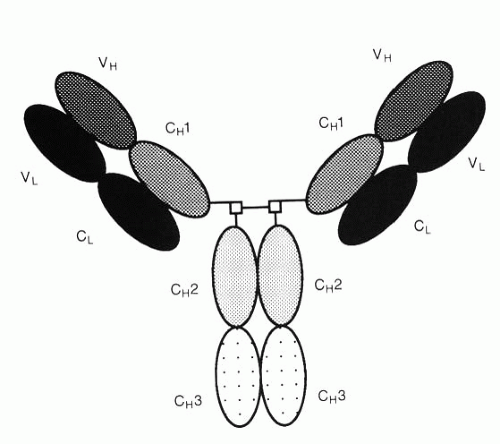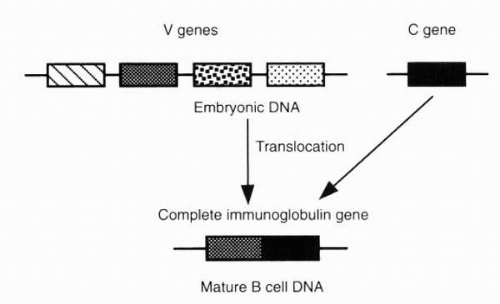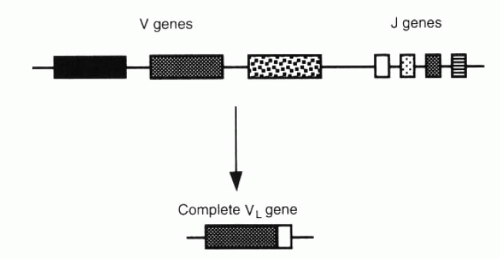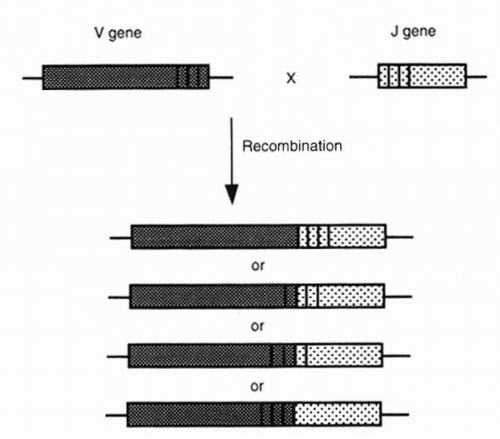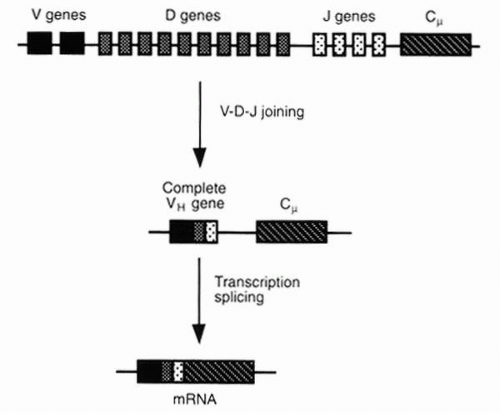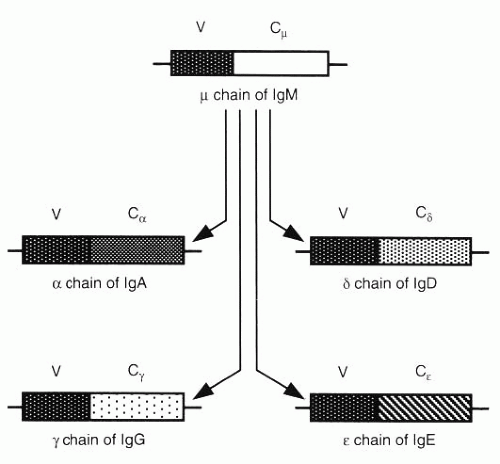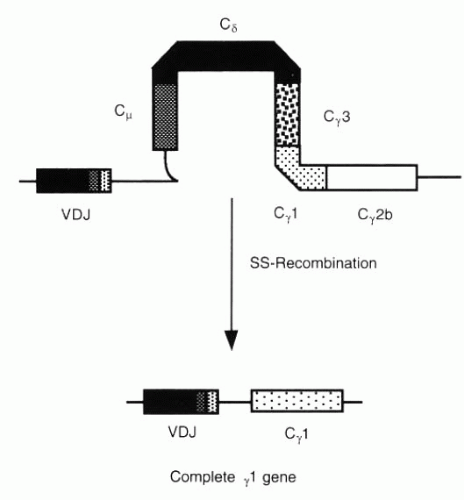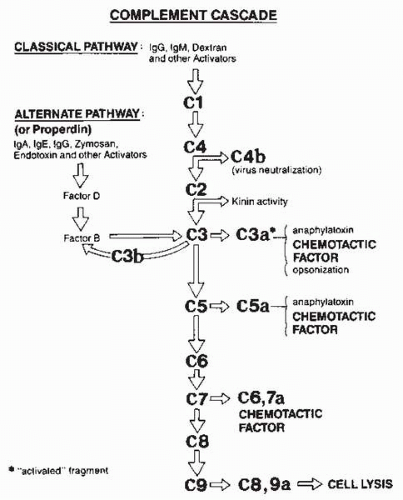Lymphocytes
Lymphocytes are mononuclear cells that are round, 7 to 8 μm in diameter, and found in lymphoid tissue (lymph node, spleen, thymus, gut-associated lymphoid tissue, mammary-associated lymphoid tissue, and conjunctiva-associated lymphoid tissue) and in blood. They ordinarily constitute approximately 30% of the total peripheral white blood cell count. The lymphocyte is the premier character in the immune drama; it is the primary recognition unit for foreign material, the principal specific effector cell type in immune reactions, and the cell exclusively responsible for immune memory.
T lymphocytes, or thymus-derived cells, comprise 65% to 80% of the peripheral blood lymphocyte population, 30% to 50% of the splenocyte population, and 70% to 85% of the lymph node cell population. B lymphocytes comprise 5% to 15% of peripheral blood lymphocytes, 20% to 30% of splenocytes, and 10% to 20% of lymph node cells.
T cells possess cell surface receptors for sheep erythrocytes and for the plant-derived mitogens concanavalin A and phytohemagglutinin. They do not possess surface immunoglobulin or surface membrane receptors for the Fc portion of antibody—two notable cell surface differences from B lymphocytes, which do possess these two entities. B cells also exhibit cell surface receptors for the third component of complement, for the Epstein-Barr virus, and for the plant mitogen known as pokeweed mitogen, as well as for the purified protein derivative of Mycobacterium tuberculosis and for lipopolysaccharide.
Null cells are lymphocytes that possess none of the aforementioned cell surface antigens characteristic of T cells or B cells. This cell population is heterogeneous, and some authorities include natural killer (NK) cells among the null cell population, even though the origin of NK cells may be in monocytes/macrophage precursor lines rather than the lymphocyte lineage. Nonetheless, the morphologic characteristics and behaviors of NK cells, along with the ambiguity of their origin, enable their inclusion under the null cell rubric. NK cells are nonadherent (unlike macrophages, they do not stick to the surface of plastic tissue culture dishes) mononuclear cells present in peripheral blood, spleen, and lymph nodes. The most notable function of these cells is the killing of transformed (malignant) cells and virus-infected cells. Because they do this without prior sensitization, they are an important component of the early natural response in the immune system. The cytotoxicity of NK cells is not major histocompatibility complex (MHC)-restricted, a dramatic contrast with cytotoxic T cells. (More about the MHC and the products of those gene loci is provided later.) But they do have recognition structures that detect class I MHC molecules; when these receptors engage class I MHC molecules on target cells, the NK cell fails to trigger cytolysis of that target cell. The large granules present in NK cells (the cells are sometimes called large granular lymphocytes) contain perforin and perhaps other cell membrane-lysing enzymes; it is the enzymes in the granules that are responsible for the lethal-hit cytolysis for which NK cells are famous.
Killer cells are the other notable null cell subpopulation. These cells do have receptors for the Fc portion of immunoglobulin G (IgG) and thus can attach themselves to the Fc portion of IgG molecules. Through this receptor, they are a primary cell responsible for cytolysis in the so-called antibody-dependent, cell-mediated cytotoxicity reaction. These cells probably participate in type II Gell and Coombs hypersensitivity reactions and are involved in immune removal of cellular antigens when the target cell is too large to be phagocytosed.
It is clear that both B cells and T cells can be further divided into specialized subsets. B cells, for example, are subdivided into the B cells that synthesize the five separate classes of immunoglobulin (IgG, IgA, IgM, IgD, and IgE). All B cells initially produce IgM specific for an antigenic determinant (epitope) to which it has responded, but some subsequently switch from synthesis of IgM to synthesis of other immunoglobulin classes. The details of the control of antibody synthesis and class switching are discussed later in this chapter. Less known is the fact that functionally distinct subsets of B cells exist, in addition to the different B cells involved in antibody class synthesis. The field of B-cell diversity analysis is embryonic, but it is clear that the exploitation of monoclonal antibody technology will distinguish, with increasingly fine specificity, differences in B-cell subpopulations. It is clear, for example, that a subpopulation of B lymphocytes possess the CD5 glycoprotein on the cell surface plasma membrane (a CD glycoprotein not ordinarily present on B lymphocytes but rather on the cell surfaces of T cells) (
3). These cells appear to be associated with autoantibody production (
4).
It is also clear now that B cells are functionally important as antigen-presenting cells (APCs) for previously primed or memory (not naive) T cells, a fact that startles most physicians who studied immunology before 1991. T-cell receptors (TCRs) cannot react with native antigen; rather, they respond to processed antigenic determinants of that antigen. APCs phagocytose the antigen, process it, and display denatured, limited peptide sequences of the native antigen on the cell surface of the APC in association with cell surface class II MHC glycoproteins. B cells, as well as classic APCs, such as macrophages and Langerhans cells, can perform this function. The antigen is endocytosed by the B cell and processed in the B-cell endosome (possibly through involvement of cathepsin D) to generate short, denatured peptide fragments, which are then transported to the B-cell surface bound to class II glycoprotein peptides; here, the antigenic peptides are “presented” to CD4 helper T lymphocytes.
Finally, regarding B-cell heterogeneity, it is becoming apparent that some B lymphocytes also have suppressor or regulatory activity. The emerging data on B-cell functional and cell surface heterogeneity will be exciting to follow in the coming years.
Much more widely recognized, of course, is that subsets of T lymphocytes exist. Helper (CD4) T cells “help” in the induction of an immune response, in the generation of an antibody response, and in the generation of other, more specialized components of the immune response. Cytotoxic (CD8) T cells, as the name implies, are involved in cell killing or cytotoxic reactions. Delayed-type hypersensitivity (CD4) T cells are the classic participants in the chronic inflammatory responses characteristic of certain antigens such as mycobacteria. Regulatory T cells (CD8) are responsible for modulating immune responses, thereby preventing uncontrolled, host-damaging inflammatory responses. It is even likely that there are sub-subsets of these T cells. Excellent evidence exists, for example, that there are at least three subsets of regulatory T cells and at least two subsets of helper T cells.
Mosmann and Coffman (
5) described two types of helper (CD4) T cells with differential cytokine production profiles. T
H1 cells secrete interleukin-2 (IL-2) and interferon-γ (IFN-γ) but do not secret IL-4 or IL-5, whereas T
H2 cells secrete IL-4, IL-5, IL-10, and IL-13, but not IL-2 or IFN-γ. Furthermore, T
H1 cells can by cytolytic and can assist B cells with IgG, IgM, and IgA synthesis but not IgE synthesis. T
H2 cells are not cytolytic but can help B cells with IgE synthesis, as well as with IgG, IgM, and IgA production (
6). It is becoming clear that T
H1 CD4 or T
H2 CD4 cells are selected in infection and in autoimmune diseases. Thus, T
H1 cells accumulate in the thyroid of patients with autoimmune thyroiditis (
7), whereas T
H2 cells accumulate in the conjunctiva of patients with vernal conjunctivitis (
8). The T cells that respond to
M. tuberculosis protein are primarily T
H1 cells, whereas those that respond to
Toxocara canis antigens are T
H2 cells. Romagnani has proposed that T
H1 cells are preferentially “selected” as participants in inflammation associated with delayed-type hypersensitivity reactions and low antibody production (as in contact dermatitis or tuberculosis), and T
H2 cells are preferentially selected in inflammation associated with persistent antibody production, including allergic responses in which IgE production is prominent (
9). Further, it is now clear that these two major CD4 T-lymphocyte subsets regulate each other through their cytokines. Thus, T
H2 CD4 lymphocyte cytokines (notably IL-10) inhibit T
H1 CD4 lymphocyte proliferation and cytokine secretion, and T
H1 CD4 lymphocyte cytokines (notably IFN-γ) inhibit T
H2 CD4 lymphocyte proliferation and cytokine production.
Macrophages
The macrophage (“large eater”) and dendritic cells are the preeminent professional APCs. Macrophages are 12 to 15 μm in diameter, the largest of the lymphoid cells. They posses a high density of class II MHC glycoproteins on their cell surfaces, along with receptors for complement components, the Fc portion of immunoglobulin molecules, receptors for fibronectin, IFNs-
α, β, and
γ, IL-1, tumor necrosis factor (TNF), and macrophage colony-stimulating factor. These cells are widely distributed throughout the various tissues (when found in tissue, they are called
histiocytes); the microenvironment of the tissue profoundly influences the extent of the expression of the various cell surface glycoproteins as well as the intracellular metabolic characteristics. It is clear that further compartmentalization of macrophage
subtypes occurs in the spleen. Macrophages that express a high density of class II MHC glycoproteins are present in red pulp, and macrophages with significantly less surface class II MHC glycoprotein expression are in the marginal zone, where intimate contact with B cells exists. It is likely that, just as in the murine system (
10), so too in humans, one subclass of macrophage preferentially presents antigen to one particular subset of helper T cells responsible for induction of regulatory T-cell activation, whereas a different subset of macrophage preferentially presents antigen to a different helper T-cell subset responsible for cytotoxic or delayed-type hypersensitivity effector functions.
Macrophages also participate more generally in inflammatory reactions. They are members of the natural (early defense) immune system and are incredibly potent in their capacity to synthesize and secrete a variety of powerful biologic molecules, including proteases, collagenase, angiotensin-converting enzyme, lysozyme, IFN-α, IFN-β, IL-6, TNF-α, fibronectin, transforming growth factor (TGF), macrophage colony-stimulating factor, granulocyte colony-stimulating factor, platelet-activating factor, arachidonic acid derivatives (prostaglandins and leukotrienes), and oxygen metabolites (oxygen free radicals, peroxide anion, and hydrogen peroxide). These cells are extremely important, even pivotal, participants in inflammatory reactions and are especially important in chronic inflammation. The epithelioid cell typical of so-called granulomatous inflammatory reactions evolves from the tissue histiocyte, and multinucleated giant cells form through fusion of many epithelioid cells.
Specialized macrophages exist in certain tissues and organs, including the Kupffer cells of the liver, dendritic histiocytes in lymphoid organs, interdigitating reticular cells in lymphoid organs, and Langerhans cells in skin, lymph nodes, conjunctiva, and cornea.
Mast Cells
The mast cell is indistinguishable from the basophil in many respects, particularly its contents. There are at least two classes of mast cells, based on their neutral protease composition, T-lymphocyte dependence, ultrastructural characteristics, and predominant arachidonic acid metabolites (
Table 3-4). Mucosa-associated mast cells (MMC or MC-T) contain primarily tryptase as the major protease (hence, some authors designate these MC-T, or mast cells—tryptase) and prostaglandin D
2 as the primary product of arachidonic acid metabolism. MMCs are T-cell dependent for growth and development (specifically IL-3 dependent), and they are located predominantly in mucosal stroma (e.g., gut). MMCs are small and short-lived (<40 days). They contain chondroitin sulfate but not heparin, and their histamine content is modest (
Table 3-5). MMCs degranulate in response to antigen-IgE triggering but not to exposure to compound 48/80, and they are not stabilized by disodium cromoglycate. They are formalin sensitive, so formalin fixation of tissue eliminates or greatly reduces our ability to find these cells using staining technique. With special fixation techniques, MMC granules stain with Alcian blue but not with safranin.
Connective tissue mast cells (CTMCs) contain both tryptase and chymase (so some authors designate them MC-TC), as well as leukotrienes B4, C4, and D4, as the primary products of arachidonic acid metabolism. CTMCs are T-cell independent. They are larger than MMCs and are located principally in skin and at mucosal interfaces with the environment. They contain heparin and large amounts of histamine, and they degranulate in response to compound 48/80 in addition to antigen-IgE interactions. CTMCs are stabilized by disodium cromoglycate. They stain with alkaline Giemsa, toluidine blue, Alcian blue, safranin, and berberine sulfate.
The ultrastructural characteristics of MMCs and CTMCs are also different. Electron microscopy shows that the granules of CTMCs contain scroll-like structures. Mast cells play a special role in allergic reactions—they are the preeminent cell in the allergy drama. However, they also can participate in type II, III, and IV hypersensitivity reactions. Their role in these reactions, aside from notable vascular effects, is not well understood. Non-IgE-mediated mechanisms (e.g., C5a) can trigger mast cells to release histamine, platelet-activating factor, and other biologic molecules when antigen binds to two adjacent IgE molecules on the mast cell surface. Histamine and other vasoactive amines cause increased vascular permeability, allowing immune complexes to become trapped in the vessel wall.
